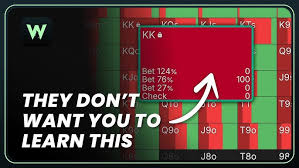If you’ve spent any time with poker solvers, you’ve likely heard the term “node locking.” At its surface, it seems simple: you tell the solver what to do in a specific spot to see how it reacts. But while many players use it to find a quick exploit, professionals approach node locking with a far more nuanced understanding. They see it not as a simple “if/then” tool, but as a way to explore the intricate, interconnected web of poker strategy.
What follows is a deeper look into what the pros understand about node locking—insights that can transform your own study and lead to more adaptable, powerful, and truly exploitative play.

1.A Poker Hand is an Ecosystem
Professionals recognize that a poker simulation is a complete ecosystem where every element is linked. A “node” is simply a specific point in a hand’s decision tree, and “locking” it means forcing the solver to take a certain action with a hand, a group of hands, or an entire range. When you lock even one small part of this ecosystem—by changing a bet size, altering a frequency, or forcing a specific action—it sends ripples through the entire simulation.
This means that if you adjust one player’s strategy, the solver will inevitably alter the other player’s strategy to counter it. You can’t just isolate a single variable; expect multiple aspects of the simulation to change in response to your lock.
2.The Solver Always Fights Back
A solver is, at its core, a maximum Expected Value (EV) machine. When you force it to take a specific action through node locking, its prime directive is to reconfigure its entire strategy to make the best of that new constraint and maximize its EV.
For example, imagine you force the solver to always check back with pocket kings on a King-7-Deuce flop. A novice might think the solver will now just have a checking range of pocket kings. But that’s not what happens. A range of only pocket kings would be incredibly easy for an opponent to exploit. Instead, the solver will build a new, well-rounded checking range around the locked kings, incorporating other hands like ace-highs, queen-highs, and low pocket pairs to protect itself and remain balanced.
3.Any Weakness Will Be Aggressively Attacked
The solver is relentless. It is designed to aggressively target any weakness it can find in an opponent’s strategy, no matter how small. The more a player deviates from a Game Theory Optimal (GTO) strategy, the more ruthlessly the solver will exploit that deviation.
Consider a scenario where two bet sizes are available, 20% and 40% pot. If you lock an opponent to always fold their ace-high hands against the 40% bet, the solver will notice. Even if the 20% bet was a frequent choice before, the solver will dramatically increase its use of the 40% bet size to capitalize on that specific, guaranteed fold. It will always gravitate towards the option that exploits a suboptimal response.
4.The Game Tree Itself Shapes Strategy
Node locking isn’t the only way to warp a simulation. Simply restricting the options available within the game tree can have a massive impact. If a solver’s preferred bet size isn’t offered as an option, it can drastically alter the strategies for both you and your opponent.
This is especially true for raise sizes. If you only give an opponent the option to make a very large or unrealistic raise (like an all-in), it will fundamentally change their initial betting range and how often they bet. The frequency and size of potential raises directly impact the EV of making a bet in the first place, so altering these options changes the entire strategic landscape.
5.Actions on the Flop Echo on the River
Poker is a three-street game, and the effects of node locking are not confined to a single street. An adjustment made on the flop creates a domino effect that cascades through the turn and river. If you lock an opponent to over-fold or under-fold on the flop, the range of hands that see the turn is fundamentally changed, leading to what can feel like “weird turn scenarios.”
For instance, if you lock your opponent to never call a flop bet with ace-high, your aggression should skyrocket on an ace turn because their continuing range will almost never contain an ace. Conversely, if you know they do call with those hands, your turn betting frequency would need to be much lower. Making the mistake of playing the turn the same way against these two vastly different ranges is a recipe for disaster.
6.Don’t Lock More Than You Know
It can be tempting to lock every single aspect of an opponent’s strategy based on your reads. Doing so will generate an “extreme max exploit” response from the solver. While this strategy might look perfect on paper against a perfectly defined opponent, it’s incredibly fragile in the real world.
In reality, you can’t know every detail of an opponent’s strategy. If your read is even slightly wrong, your hyper-specific exploitative strategy can backfire, causing you to be the one who gets exploited. The golden rule is this: the extent of your node locking should directly mirror your level of confidence in your read. You can even combine different types of locks—for instance, adjusting a general folding frequency and then locking a few specific hands within that frequency—to better reflect your nuanced reads.
The True Goal: Understanding Relationships
Ultimately, pros use node locking not to memorize specific, rigid strategies. The real goal is to develop a deep, intuitive understanding of the relationships between the countless variables the solver is weighing.
By studying how common leaks and tendencies affect optimal responses, pros build a mental framework that allows them to adapt on the fly at the table, without needing to have studied every single possible scenario. It’s about learning how different variables push and pull on your strategy so you can make better adjustments in the heat of the moment.
